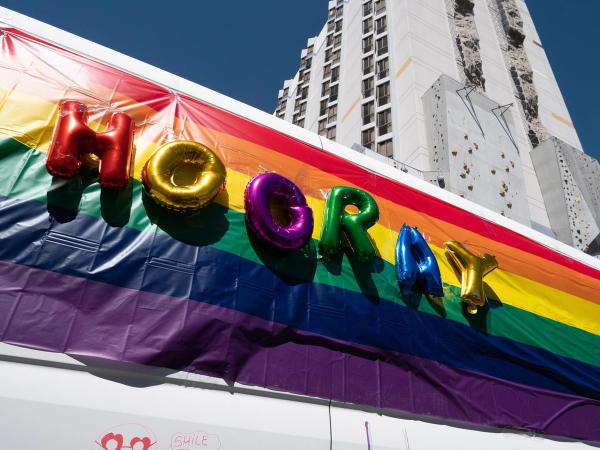Celebrating LGBTQIA+ History Month

📚 The history
LGBTQIA+ History Month was created in 1994 by Missouri high school teacher Rodney Wilson. Wilson, along with community leaders, sought to teach students about the queer trailblazers so often ignored by textbooks.
- October was selected because National Coming Out Day already fell on the 11th and because the first National March on Washington for Gay and Lesbian Rights occurred on October 14th, 1979.
- In 1995, the National Education Association officially voted to include LGBTQIA+ History on its list of commemorative months, and the rest, as they say, is history.
💪 The trailblazers

One of the first pro athletes to come out was former NFL running back David Kopay. In 1975, three years after retiring from the league, Kopay acknowledged his sexuality in an interview and, two years later, published a book detailing his journey to self-acceptance.
On the tennis court, activist and icon Billie Jean King was horrifically outed when a former lover sued her for palimony in 1981, and legend Martina Navratilova was also outed a few months later by the New York Daily News before she was ready to come out.
- But a lesser-known trailblazer fought the U.S. Tennis Association in court. After being barred from the 1976 US Open for refusing to take a sex-verifying blood test, trans athlete Renée Richards sued, and, in 1977, the NY Supreme Court ruled that the test was discriminatory and in violation of Richards’ human rights. Serving equality.
Putting the “out” in outfielder is the first openly gay MLB player, Glenn Burke. The former LA Dodger and Oakland A (and inventor of the high five!) came out publicly in 1982, three years after his last MLB appearance.
In more recent history, 2013 saw the first active out athlete in major men’s North American sports when Robbie Rogers took to the MLS pitch for the LA Galaxy.
- And in men’s hoops, center Jason Collins also came out in 2013 and became the first active openly gay NBA player when he joined the Brooklyn Nets in 2014. That year, he wore number 98 in honor of the late Matthew Shepard, a student who was brutally murdered for his sexuality in 1998.
🌈 Loud and proud

Thanks to those aforementioned trailblazers, some of today’s athletes feel safe to be their true selves on and off the field. WNBA star Layshia Clarendon wrote a memorable 2015 The Players’ Tribune article identifying as non-cisgender, making them the WNBA’s first openly nonbinary athlete.
- Then, in 2021, Clarendon bravely underwent top surgery and finally felt a “sense of gender euphoria as opposed to gender dysphoria.” Authenticity FTW.
Sadly, there are far fewer openly LGBTQIA+ athletes in men’s leagues than in women’s, but two players — in football and fútbol — recently continued blazing trails.
- Former Las Vegas Raider Carl Nassib (who’s now retired) became the first openly gay active NFLer in 2021, making the announcement in a video on Instagram.
On the pitch, Blackpool’s Jake Daniels made history in 2022, becoming the U.K.’s first active openly gay player since Justin Fashanu in 1990.
- “I am only 17 but I am clear that this is what I want to do,” he said in the announcement. “And if, by me coming out, other people look at me and feel maybe they can do it as well, that would be brilliant.”
- Also brilliant? The day after he came out to his family, Daniels scored a whopping four goals in a scrimmage. A weight off his shoulders.
And a few months later, Hampton University defensive back Byron Perkins came out as gay, becoming the first-ever out HBCU football player in the process. Perkins said he hopes his move to live authentically combats stigma and increases support for young Black gay men.
🥊 The fight continues

Though sports and society have made significant strides toward equality, there’s still a long way to go.
In 2015, a massive international study surveyed nearly 9.5K individuals, both queer and straight, and found that 80% had seen or experienced homophobia in sports, and the same proportion believe queer people are “not at all” to just “moderately” accepted in sporting culture.
- Even more concerning, 73% believe team sports are not safe for queer youths and 78% question the safety of LGBTQIA+ individuals as mere spectators at sporting events.
And besides still combatting homophobia, there’s also a massive fight around transgender athletes and their access to sports. While a few states are going so far as to ban gender-affirming healthcare for trans youths, when it comes to sports, 23 states ban trans student-athletes from competing in sports consistent with their gender identity.
As politicians use the idea of “protecting women’s sports” as a pawn in their transphobic arguments, it’s athletes and trans kids who suffer as they’re ostracized from competitive sports spaces.
- Former UPenn swimmer Lia Thomas drew significant ire for competing according to her identity after transitioning “to be happy, to be true to myself” beginning in 2019.
- And earlier this year, the International Cycling Union banned transgender women from competing in the female category of competitive events, following the horrifying leads of FINA, the world governing body of swimming, and the International Rugby League.
It’s clear that the next chapter in LGBTQIA+ sports history will require all of us to fight, particularly in protecting trans kids.
- To echo USWNT star Megan Rapinoe, “show [us] the evidence that trans women are taking everyone’s scholarships, are dominating in every sport, are winning every title. I’m sorry, it’s just not happening. So we need to start from inclusion, period…we can’t start at the opposite. That is cruel.”
Enjoying this article? Want more?

Sign up for The GIST and receive the latest sports news straight to your inbox three times a week.

